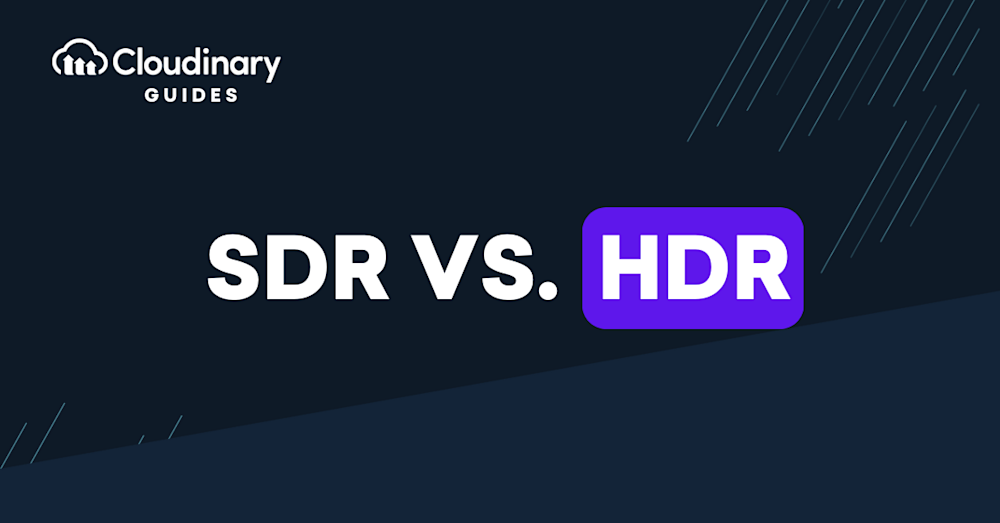What Is SDR?
Standard Dynamic Range (SDR) refers to a display technology that has a limited range of brightness levels and color gamut compared to High Dynamic Range (HDR) displays. They are commonly used in traditional display technologies such as CRT displays, which have a limited ability to reproduce a wide range of colors and brightness levels.
SDR is still widely used today in many consumer electronics, including televisions, computer monitors, and mobile devices, especially in devices with smaller screens where the visual benefits of HDR are less noticeable.
This is part of a series of articles about Image Formats.
What Is HDR?
High Dynamic Range (HDR) is a more advanced display technology that provides a wider range of brightness levels and colors than Standard Dynamic Range (SDR).
HDR displays can produce a peak brightness of up to 10,000 nits, significantly higher than the 100-300 nits of SDR displays, and a wider color gamut that can display billions of colors. This results in more realistic and immersive images with greater contrast and detail, especially in bright and dark areas of the image.
HDR content can be created using a variety of methods, including capturing multiple exposures of the same scene and combining them into a single HDR image or using specialized cameras capable of capturing a wider range of brightness levels. HDR is becoming increasingly popular in consumer electronics, including televisions, computer monitors, and mobile devices.
In this article:
Pro Tip
Consider Cloudinary Video API
When working with video, consider using Cloudinary’s Video API, which offers real-time video transcoding, content-aware compression, on-the-fly video transformation, and more.
-> Learn More About the Capabilities of Cloudinary’s Video API
FAQ
What’s better, 4K SDR or 1080p HDR?
The comparison between 4K SDR and 1080p HDR depends largely on the display you’re using and the content you’re viewing. If you’re watching content that is mainly focused on detail and resolution, then 4K SDR may be better because it has four times the pixels of 1080p, providing a clearer and more detailed image.
However, if you’re more interested in color range and contrast, 1080p HDR could be the better choice. HDR improves the color and brightness of the images, providing more vivid and lifelike visuals. Even though it has less resolution, the enhancement in color and contrast could make a significant difference in the viewing experience.
Again, it also depends heavily on your display’s capabilities. If your display can handle 4K resolution as well as HDR, that would give you the best of both worlds.
Is SDR or HDR better for gaming?
HDR is considered better for gaming as compared to SDR. The primary advantage of using HDR for gaming is how it can add depth and detail. It offers a wider color gamut, which means a larger and richer range of colors can be displayed on the screen. This leads to more vibrant and lifelike colors, making the game visuals more immersive and appealing.
In addition, HDR provides a higher contrast ratio. This means that it can better differentiate between the dark and bright areas on the screen, allowing for more detailed and dynamic imagery. Elements like reflections, specular highlights, and textures appear more lifelike in HDR, thereby boosting the overall gaming experience.
While SDR gaming is still capable of delivering good visuals, it falls short in terms of color depth and contrast. SDR may not portray certain visual elements as vividly as HDR. Therefore, for a more immersive and realistic gaming experience, HDR would be the better choice over SDR.
SDR vs. HDR: Comparison and Key Differences
Here are some of the main points of difference between SDR and HDR technologies.
Metadata
One of the key differences between Standard Dynamic Range (SDR) and High Dynamic Range (HDR) is the amount and type of metadata used to describe the content being displayed. Metadata refers to additional information that is stored alongside the visual content to provide additional details about how the content should be displayed.
Static and dynamic metadata
In SDR, metadata is typically static and applies to the entire video stream. For example, the color space, gamma curve, and brightness levels are usually fixed throughout the entire video. This means that the display device does not have a lot of flexibility in terms of how it renders the content.
In contrast, HDR content includes dynamic metadata that describes the brightness and color information on a scene-by-scene or even frame-by-frame basis. This metadata allows the display device to adjust its settings to optimize the visual experience based on the specific content being displayed.
Formats
There are several dynamic metadata formats used in HDR content, including HDR10+, Dolby Vision, and Technicolor HDR. HDR10+ is an open standard developed by Samsung, Panasonic, and 20th Century Fox that uses dynamic metadata to adjust the brightness and color information in real-time. Dolby Vision, on the other hand, is a proprietary format developed by Dolby that uses dynamic metadata to adjust the brightness, contrast, and color information based on each scene.
Dynamic metadata provides several benefits over static metadata, including more accurate color representation, better contrast, and improved brightness levels. This allows HDR displays to produce images with more depth, dimensionality, and realism, resulting in a more immersive viewing experience.
Color Gamut
Color gamut refers to the range of colors that a display device is capable of producing. It is typically expressed as a percentage of the full color spectrum, with a larger percentage indicating a wider range of colors.
While HDR displays have a wider color gamut than SDR displays, SDR can still be useful for displaying colorized work because the color gamut of SDR displays is well-defined and standardized. This means that color grading and correction can be done with greater accuracy and consistency, making it easier to ensure that the intended colors are displayed correctly.
Additionally, SDR content can be easily and widely distributed and viewed on a variety of devices, including older displays that do not support HDR. This means that content creators can still reach a large audience with SDR content, even if it may not have the same visual impact as HDR.
Brightness
SDR displays typically have a brightness range of 100-300 nits, which is suitable for most everyday viewing environments. In contrast, HDR displays can produce a peak brightness of up to 10,000 nits, significantly higher than the brightness range of SDR displays. This higher brightness range allows HDR displays to produce more detail and contrast in bright areas of the image, resulting in a more realistic and immersive viewing experience.
HDR also supports a wider range of brightness levels, which means that it can display both very bright and very dark areas of an image with more detail and accuracy compared to SDR. This wider range of brightness levels is achieved through the use of advanced tone mapping algorithms that adjust the brightness and contrast of the image in real-time based on the content being displayed.
Depth of Color
Color depth refers to the number of bits used to represent each color channel. SDR typically uses 8 bits per color channel, resulting in a total of 24 bits per pixel (8 bits each for red, green, and blue). This allows for a maximum of 16.7 million colors to be displayed, which is sufficient for most everyday viewing environments. For comparison, the human eye only distinguishes approximately 10 million colors.
In contrast, HDR displays support higher color depths, typically 10 or 12 bits per color channel. This allows for a much wider range of colors to be displayed, up to billions of colors. The increased color depth allows for smoother gradients and more subtle color variations, resulting in more realistic and accurate images.
SDR vs. HDR: 5 Key Considerations for Content Creators
When deciding between SDR and HDR for content creation, it’s essential to consider several factors that can impact the quality of your work and the viewing experience of your audience. Here are some key considerations for content creators.
-
- Production workflow: HDR content requires a more complex production workflow, including specialized cameras, monitors, and software that can handle the higher dynamic range and color depth. This can increase the cost and complexity of your production process. SDR, on the other hand, has a more simplified workflow and may be more accessible for smaller production budgets.
- Post-production: Color grading and correction are critical aspects of video post-production. HDR content can provide more flexibility during post-production due to the wider color gamut and dynamic range. However, working with HDR footage may require more advanced skills and tools to manage the increased complexity.
- Distribution: When it comes to distributing your content, HDR content may be more limited in terms of compatibility with older devices or streaming services that don’t yet support HDR. SDR content is more widely compatible with various devices and platforms, making it easier to reach a larger audience.
- Audience preferences: As HDR technology becomes more widespread, viewers may start to prefer HDR content for its enhanced visual quality. However, not all viewers have access to HDR-capable devices or may not notice the difference in quality on smaller screens. Consider your target audience and their viewing preferences when deciding between SDR and HDR.
- Future-proofing: HDR is becoming the industry standard, and it’s likely that more and more content will be produced in HDR in the coming years. By creating HDR content now, you can ensure that your work is future-proof and compatible with the latest display technologies.
Leveraging HDR and SDR with Cloudinary for Optimal Content Delivery
As content creators navigate the evolving landscape of display technologies, the choice between HDR and SDR can significantly impact the viewer’s experience. While HDR offers enhanced brightness, color depth, and realism, SDR remains crucial for compatibility and accessibility across various devices. This dichotomy presents a unique challenge: how to optimize content for both technologies without compromising on quality or reach.
Cloudinary emerges as a powerful solution in this scenario. With Cloudinary’s advanced media management platform, creators can seamlessly transform and optimize media files for both SDR and HDR formats. The platform’s dynamic adaptation capabilities ensure that your content is delivered in the optimal format, balancing file size and quality based on the viewer’s device capabilities and network conditions.
Moreover, Cloudinary’s real-time image and video manipulation tools allow you to easily apply transformations to fit the specific requirements of HDR and SDR outputs. From adjusting brightness levels to enhancing color contrasts, Cloudinary enables detailed fine-tuning that ensures your content looks stunning in almost any format.
Related content: Read our guide to EPS Format and SVG format.


